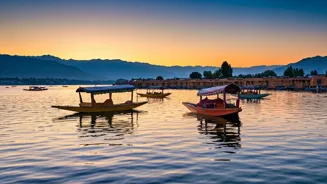Geography and Beauty
Dal Lake is located in the beautiful valley of Kashmir, nestled within the city of Srinagar. It's a vital part of the J&K region and is renowned as the 'Jewel
in the crown' of Kashmir, attracting a multitude of tourists. The lake itself is known for its scenic beauty, encircled by the majestic snow-capped mountains that create a breathtaking backdrop, with houseboats and shikaras. The lake is divided into various basins; Gagribal, Lokut Dal, Bod Dal, and Nagin, each one contributes to its varied and captivating vista. The lake’s environment supports a variety of flora and fauna, making it a rich ecosystem in its own right, and offering a unique setting for both local residents and the many visitors it sees annually.
Cultural Significance
Dal Lake is deeply woven into the cultural fabric of Kashmir. It's home to a unique lifestyle, particularly among the local communities who live on and around the lake. These communities have long been dependent on it for their livelihood, including fishing and the cultivation of vegetables in floating gardens, known as 'Rad'. The lake is a popular tourist destination and a source of inspiration for poets, artists, and writers, who often visit it for inspiration. The tranquil waters and the traditional houseboats, or 'Shikaras' which are still actively used today, along with the daily life on the lake, offer visitors a glimpse into the rich cultural heritage of Kashmir. It is not just a body of water, it is a symbol of the Kashmiri identity.
Tourism's Influence
Tourism plays a crucial role in the economy of Dal Lake and the surrounding area. The lake is a major draw for tourists, who come to enjoy houseboat stays, Shikara rides, and the scenic beauty. This tourist influx provides income for local businesses, including houseboat owners, Shikara operators, vendors, and others involved in the tourism sector. However, the growth of tourism has also presented challenges. The increasing number of tourists has led to environmental concerns, and putting strain on the lake's resources, as well as increasing pollution in the waters. Therefore, responsible tourism practices are essential to ensure that the lake's charm is preserved for future generations. Managing the balance between promoting tourism and protecting the environment is crucial for the sustainable development of Dal Lake.
Environmental Concerns
The health of Dal Lake faces a range of environmental challenges. Pollution, resulting from untreated sewage, waste disposal, and agricultural runoff, has a substantial negative effect on water quality. Sedimentation, which is mainly due to erosion in the catchment areas and other human activities, has led to the lake becoming shallow over time. Climate change also presents threats, as changing weather patterns affect the lake's ecosystem. Additionally, the presence of invasive species can disrupt the native flora and fauna, leading to imbalances. Addressing these environmental concerns requires an integrated approach, with pollution control, sustainable waste management, and habitat conservation, to safeguard the long-term health and beauty of Dal Lake for future generations.
Conservation Efforts
Recognizing the pressing environmental issues, various conservation efforts are underway to protect and rejuvenate Dal Lake. These initiatives include measures to control pollution, such as the construction of sewage treatment plants and programs to reduce waste. Regular dredging operations are conducted to remove sediment and restore the lake's depth. The authorities are actively promoting sustainable tourism practices, as well as educating locals and tourists about the importance of environmental preservation. A variety of government and non-government organizations have also been involved in these efforts, including community-based initiatives, which have proven to be critical for success. These collaborative actions aim to restore the lake's ecosystem and to preserve its natural beauty for generations.

